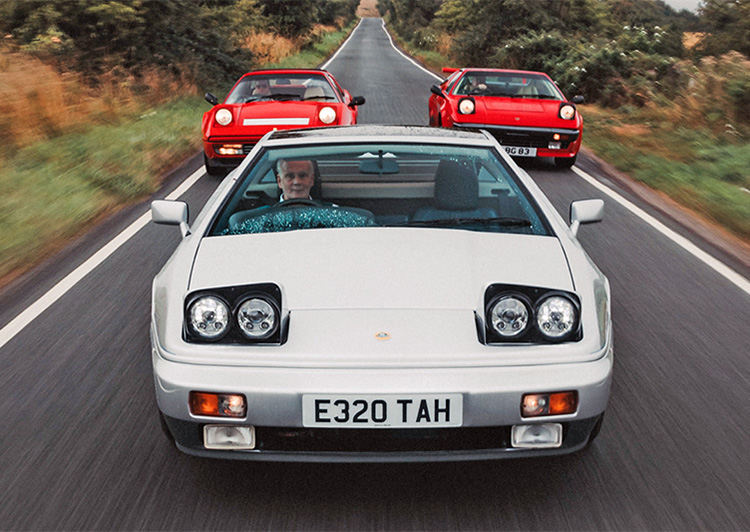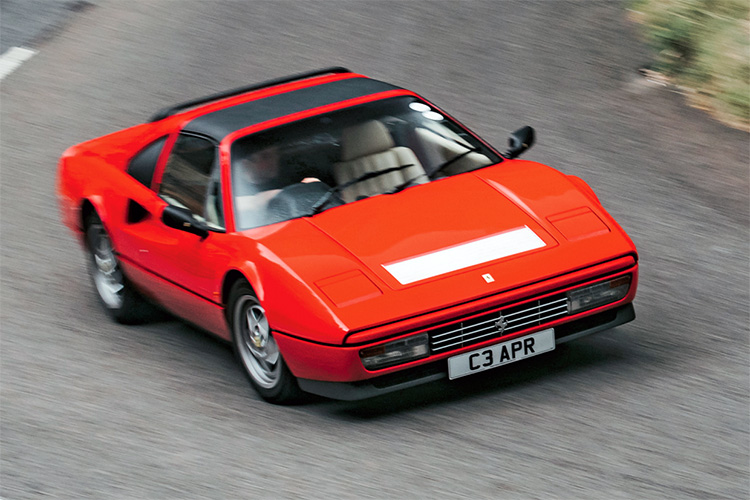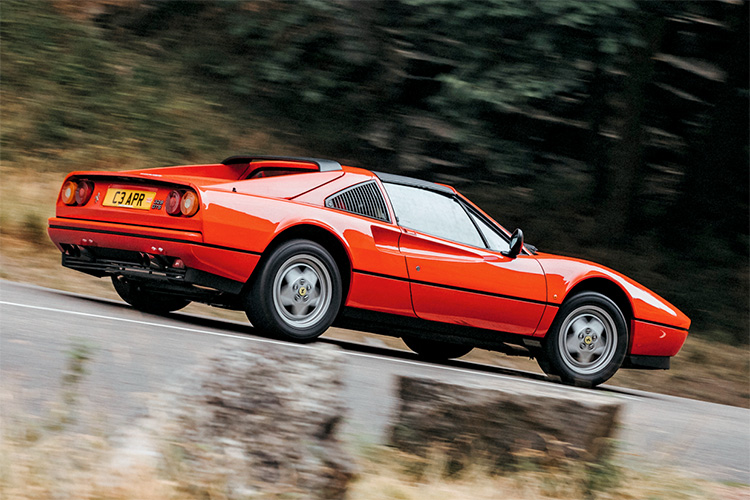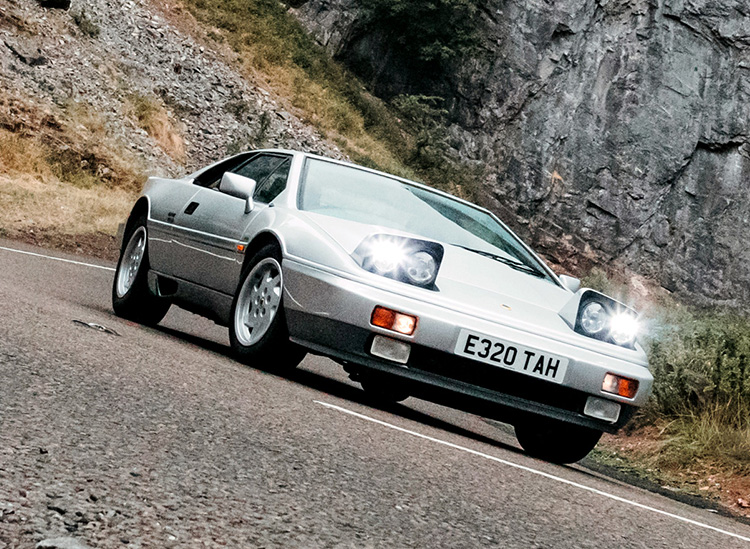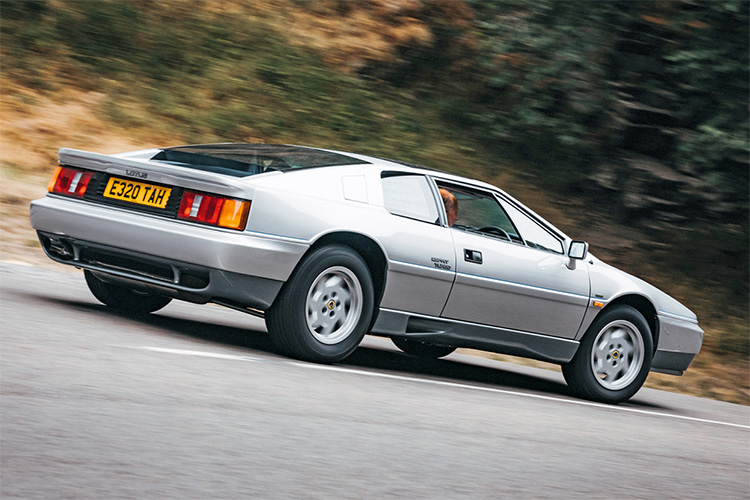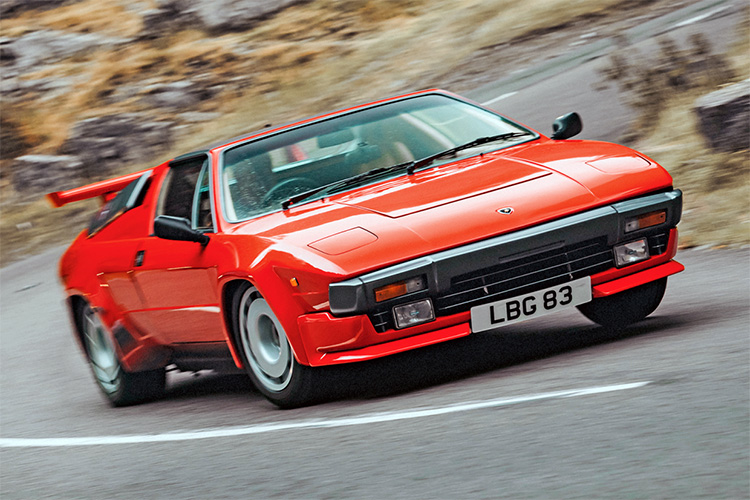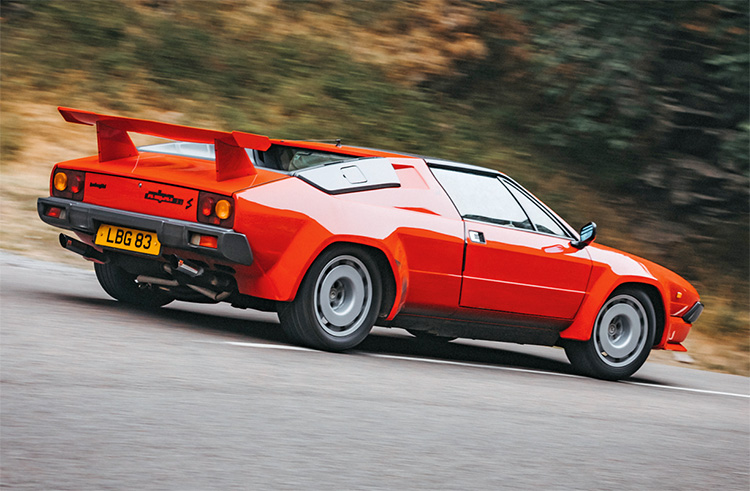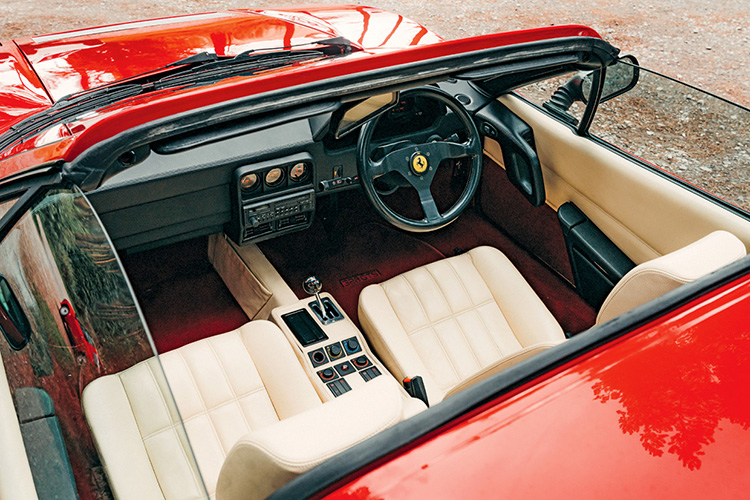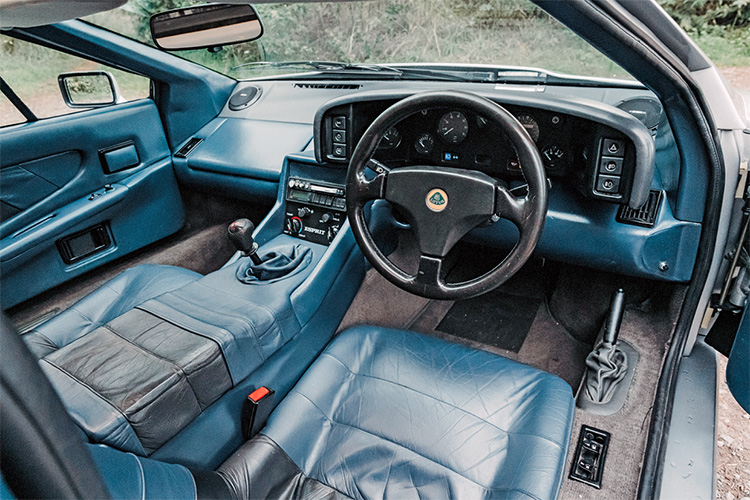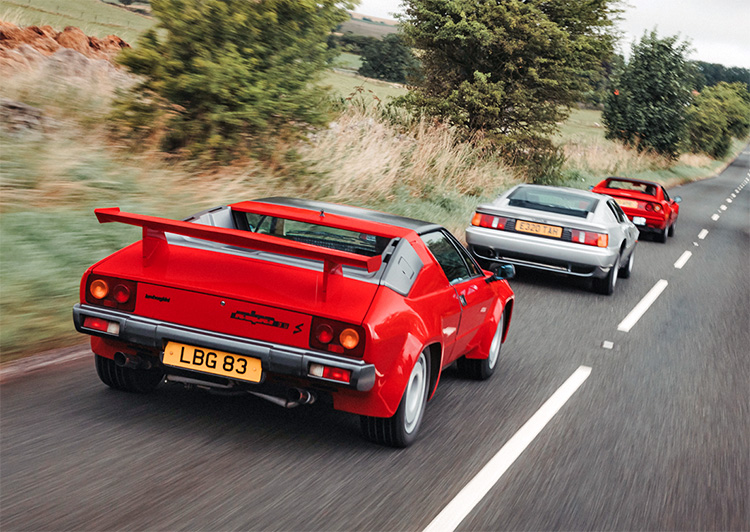
Supercar Showdown
Ferrari 328GTS vs Lotus Esprit Turbo vs Lamborghini Jalpa:
Classic & Sportscar magazine
March 2023
It
would be a completely different story in a Testarossa. The arrow-like
nose of the 328 darts to avoid a collection of rocks strewn across
the Cheddar Gorge asphalt, nipping its narrow Pirellis just across
the centre line.
The gearshift happens instinctively, a flurry of revs barks the
sound of Ferrari’s flat-plane-crank V8 on to the sheer faces
of rock, and this flash of red twists nimbly around a succession
of hairpins.
We’re not going too quickly, but navigating an exotic supercar
between 400ft towers of slate and stone has a dramatic satisfaction
to it, especially when it’s not hard work.
Carving
a path through Cheddar Gorge in the Lamborghini Jalpa (closest),
Lotus Esprit Turbo (middle) and Ferrari 328GTS
In this snarling wake of buzzing sound waves, the smooth-lined Lotus
Esprit X180 glides almost silently behind, a calm tonic for both
the ears and eyes.
Letting loose only the occasional wastegate flutter from its avant-garde
shape, it’s a neat-looking car that assuredly promises all
the engineering detail befitting the flagship of Norfolk.
Then, like an approaching weather front, comes the heavy rumble
of the Lamborghini Jalpa’s cross-plane-crank V8.
It’s a showpiece of jagged angles and wild noises, easing
along seemingly in one, long gear, carrying its passengers on an
effortless slug of torque.
The Ferrari’s ‘double-shell’ design follows on from the Berlinetta Boxer
The supercars of the 1980s set a new standard for a class that had
hitherto been an exclusive arena for punishing cars supplying only
hard-earned rewards.
The idea of practical dimensions, let alone comfortable cabins,
and controls that would accommodate the sightseeing whims of a driver
visiting the narrow confines of a geological feature, were hardly
imagined when Enzo Ferrari, Colin Chapman and Ferruccio Lamborghini
set out to create their ultimate performance machines.
But it was a reality that was absolutely necessary for the continuation
of each of these famed marques.
When the deal that saved Ferrari was completed in 1960 and Fiat
obtained 50% of the Modenese racing company that – at least
from The Old Man’s perspective – also made road cars,
the need for a junior supercar was clear.
The Dino 206GT appeared in 1967 and, while it wasn’t necessarily
what you’d describe as an easy car to drive, it was infinitely
more pliable than the grumbling, spitting, rebodied racing cars
that Ferrari had previously offered to high-performance customers.
The Fiat influence had even brought Formula One success back to
the Prancing Horse in 1975 and, the same year, the release of the
first Ferrari-badged baby, the 308, was primed to bring production
at the Scaglietti works into the thousands annually.
Lower skirts, spoilers and larger wheels give the Ferrari 328 more of a ground-hugging appearance than its 308 predecessor
By the introduction of the revised 328 in 1986, this had become
a reality and Ferrari was approaching a new era of prosperity –
one that, after 14 August 1988, would be without Enzo.
The one-time customer and, later, infamous rival of Ferrari, Ferruccio
Lamborghini, had plans for a junior supercar from early on.
But delays and compromises would come to define this endeavour at
every turn, from the Marcello Gandini-designed Urraco that wowed
crowds at the 1970 Turin motor show, only to hover in pre-production
until 1972, via the short-lived Silhouette to the hopeful but ultimately
troubled birth of the Jalpa in 1982.
The softer X180 Esprit was a Peter Stevens restyle of the original ’70s design
Entering the rather supercar-unfriendly 1970s already in a state
fragile enough to convince a reluctant Ferruccio Lamborghini to
sell out to two wealthy Swiss businessmen, Georges-Henri Rossetti
and René Leimer, the supercar maker of Sant’Agata fell
into official bankruptcy in 1978.
More Swiss money came in, this time from the Mimran brothers, who
made plans for a ‘Nuova Automobilia Ferruccio Lamborghini’,
including updates for the Countach and a crucial new junior supercar,
tweaked by Giulio Alfieri, the eminent former Maserati engineer.
Delayed, naturally, the Jalpa finally reached series production
two years after its debut at Geneva.
Lotus never had any problem distilling the essence of its cars.
Its challenge was wrangling with the modern requirements of mass
production and quality control.
Much like Enzo, Colin Chapman had focused on his racing efforts
and, at least in the early days, the road cars were a means to an
end, reluctantly offered to the public.
But, thanks to the inspired efforts of engineers such as Tony Rudd,
product development at Hethel had enough momentum to bear the idea
of a new mid-engined supercar.
The drag coefficient was up by 0.01 to 0.35Cd for the X180 Esprit Turbo, but its aerodynamics were more sophisticated
Based on an Italdesign show car, the resulting Esprit was undoubtedly
a classic work of Lotus: light and high-performing, but also shackled
to modest manufacturing and distribution capabilities.
Chapman had made promising inroads to the American market, but it
was further development after his death that secured Lotus a spot
in this new era of usable, mass-produced supercars.
The brief, decisive leadership of British Car Auctions founder David
Wickins, and the subsequent buyout by General Motors in 1986, led
to the X180 Esprit: a car with global, mass-market potential.
The Lamborghini Jalpa is the heaviest of this trio, but it compensates with instant thrust from the 3485cc V8
The Ferrari’s conical air intakes and recessed rear window
carry undeniable echoes of the Dino, but its overriding character
more closely reflects the Berlinetta Boxer’s edgy dynamism.
You can almost see how its flat body panels – glassfibre on
the first 308s, but now steel – hang on the lean spaceframe
beneath, and the way the top and bottom halves join at the waistline,
just like its bigger brother.
The new, ground-hugging skirts and spoilers of the 328 spoil the
purity of purpose for some, but it would have been essential for
the Ferrari when facing up to the longer, wider and taller competition
here.
It begs to be driven, and as you’re settling yourself down
towards the delicate-looking seat, you’re already prepared
for a substantial amount of discomfort.
Sure enough, your body twists awkwardly against the thigh bolsters
to align with the pedals and the steering wheel dictates a subtly
different angle of its own, but it’s surprising how compliant
the controls are, even when cold.
Navigating the gated gearlever and narrow town streets alike are
not to be feared, and there’s a confidence-inspiring sense
of solidity that suggests this could be an excellent long-distance
companion – apart from the backache, perhaps.
The Lamborghini Jalpa is the ultimate development of the 1972 Urraco
The best remedy for – or at least distraction from –
any awkwardness is a flex of the right foot. The 3.2-litre, 32-valve
V8 immediately jumps to attention with enthusiasm.
A click through the metal gate into a lower gear blows everything
away – absorbing admiring glances from the public at 7mph
or the impressively quiet conversation you were holding at 70mph
– and your senses are captured by the searing howl of a race
to 7000rpm.
The next gear is better than the last, and they’re stacked
close enough together so that even a dance through to fourth needn’t
endanger your licence.
Countach-style
rear wing wasn’t part of the Lamborghini’s (foreground)
original design; the Esprit (right) is fastest to 60mph, while the
328 is the most exciting to drive
Despite a pedalbox narrowed by the 328’s wider 16x7in wheels,
you don’t need bespoke Italian shoes to heel-and-toe effectively.
The brakes respond positively, uncorrupted by the addition of ABS
– an upgrade made in 1988, presumably stirring Enzo in his
grave almost as much as the excellent air conditioning.
The steering is very much unassisted, but, at 3.1 turns lock to
lock, the Momo wheel finds an ideal weight at anything above crawling
speeds.
It offers the best feel of the three, closely followed by the Lotus,
but the Ferrari gains a decisive advantage with its feedback through
the seat. Even on greasy asphalt, between unyielding walls of rock
and with the threat of debris or wandering tourists, the 328 encourages
you to explore its natural balance – on the throttle, on the
brakes, and pushing the edges of its still relatively narrow tyres.
The Esprit has the best chance here of showing the 328 some tail-lights.
It stacks up as the fastest to 60mph, over the quarter-mile and
the standing kilometre, and as soon as you pin the throttle you’re
convinced that its turbocharged shove is stronger than the Ferrari’s.
There’s a satisfying sure-footedness to the way it threads
its way through corners, too, suggesting that fine damping and the
most equally balanced weight distribution here – 49:51 as
opposed to the Ferrari’s 46:54 and Lamborghini’s 43.2:56.8
– have given the Esprit the sort of British engineering advantage
that would have once embarrassed certain ‘grand manufacturers’
on the track.
However, the performance of this early X180 comes apart at the edges.
This is the very car that gave the new-shape Esprit its Earls Court
debut in ’87, but perhaps a later car might have been better
able to handle the Ferrari.
Lotus uprated the X180 almost every year, finding a sweet spot in
the 1989 Turbo SE, complete with Goodyear Eagle tyres, revised suspension
and charge-cooled 264bhp engine.
Ferrari’s 328GTS lacks a glovebox and its footwell was compromised by bigger wheels
Here and now, however, there’s a certain polish missing that
prevents the Lotus from matching the Modenese car’s delicacy
and ultimate ability.
And yet there’s something utterly charming, and somewhat unexpected,
about the Esprit that develops more out of its conservative shape
and serious approach to tackling a road. The whoosh of the turbo
inspires thoughts of the next age of supercars, while the twin Dell’Orto
carbs offer a thrilling gargle in the background. It generates impressive
grip, and the sharp brakes and slick gearbox inspire confidence,
even if it does feel a little less sure of itself at the limit compared
with the 328.
Next to the extroverted Italians, the Lotus has an air of elegance
and quiet confidence.
The crisp, minimal detail in Peter Stevens’ neat redesign
is exemplified perfectly by the floating glass ‘tunnel-back’
rear panel over the engine cover. It’s an addition that subtly
designates this as a Turbo model and hints at other, unseen aerodynamic
features at work, such as the carefully profiled undertray that
helps cool the engine and brakes.
Inside, the Esprit is a big improvement over earlier cars and the
impression is of a modern, resolved design – helped in no
small part by the large, smoked-glass lift-out sunroof (the other
two have painted removable panels).
However, those initial impressions inevitably fade to disappointment
as you begin to spot clumsy stitching and mismatched air vents.
The money has been spent beneath the surface. The glassfibre panels
that form the body around its steel backbone chassis used the novel
new Vacuum Assisted Resin Injection process that meant Lotus could
produce six bodies a day.
A
large glass engine cover formed a ‘tunnel-back’ rear
for this classic Lotus
Reinforced with Kevlar around the roof and sides, and glassfibre-covered
polyurethane foam in the sills, its torsional rigidity was greatly
increased – but so was weight, which was now marginally above
the 1325kg claimed for Ferrari’s relatively old-fashioned
spaceframe 328.
The Lamborghini suffers the most with its heft, however, coming
in at a considerable 1407kg, and it is surprising to note that it
has the relative sophistication of a semi-monocoque and a stressed
steel body.
While undoubtedly the ultimate development of the Urraco, the legacy
of the baby Lambo’s rush to production still left it feeling
like an Airfix model with the sprues not yet filed off.
The revised X180 Lotus Esprit was roomier than its predecessor
Fortunately, it has the engine to compensate. While the Ferrari
is still winding its twin overhead camshafts up towards a 5500rpm
torque peak and the Lotus is summoning its 9.5psi of boost, the
Jalpa explodes instantly under your right foot.
In almost any gear, it feels as though all of its 231lb ft is ready
to snap the reins tight and catapult you down the road, over the
hill and beyond the horizon.
Noting that the peak is at 3500rpm seems almost arbitrary amid the
thunderous sound and savage scramble for speed.
The
Jalpa sits more squarely than the earlier, short-lived Lamborghini
Silhouette
It also has an appetite for gears, with the shortest ratios here,
but switching between them isn’t as slick as it is in the
other two – although it’s a marked improvement over
the two-handed action required in the larger Countach.
Conversely, the Jalpa’s low-geared steering, at 4.2 turns
from lock to lock, makes for response at the wheel that is more
relaxed than the Ferrari’s hyper-agile turn-in and the lower-geared
but more linear Lotus.
The Jalpa’s controls, including the awkwardly placed pedals,
serve only as facilitators to unleash the savagery of the engine,
rather than to offer much joy in themselves.
A modular dashboard disguises the Jalpa’s off-the-shelf dials
They nearly disguise the fact that the Lamborghini has tidy handling
with a balance that promises to be sweet, even if you know better
than to test it.
The brakes have the softest response here, but at the same size
as the others they ought to have similar ultimate performance.
It rides well, too, at least at speed, and the Jalpa has the most
spacious cabin of the trio, with the best seats – albeit still
very much for slender Latin types.
There’s an overwhelming sense of grand-touring glamour about
the Lamborghini that has you imagining taking it to the south of
France. Shame, then, that the remarkably low gearing would make
it fussy – and thirsty – over a long cruise.
Much of its star-sprinkled character is derived from the wild styling.
It achieves all the drama you’d expect of a baby Lamborghini,
but it was a new design language that birthed the Jalpa, different
to Gandini’s ill-fated Countach-in-miniature Bravo concept
of 1974.
Taking the lead instead from the 1980 Athon show car, an edgy spider
of overlapping shapes designed by Frenchman Marc Deschamps, the
square-jawed Jalpa has half-hexagonal wheelarches and flat OZ wheels,
although the production drop-top was never realised.
The car was originally designed with a subtle boot spoiler, but
a Countach-style wing was a last-minute addition, while the more
classically styled teledial wheels from the Silhouette became an
option in 1984.
Bertone’s ‘styling exercise’ was in truth a slightly
desperate attempt by Lamborghini’s new owners to drum up business.
It would also be the last car from Sant’Agata styled by Nuccio’s
design house.
Blending Lamborghini’s trademark exhilarating brutality and
sci-fi looks with a surprising amount of passenger comfort and luggage
space, the Jalpa feels like a creative success – if not a
commercial one.
‘The junior supercars of the 1980s set a new standard for a class that had hitherto been an exclusive arena for punishing cars supplying only hard-earned rewards’
Lotus already had design success, but with the more refined, practical
and production-efficient X180 it secured another 16 years for the
Esprit and was a landmark for Norfolk continuing to add lightness
without so much compromise.
All three are exciting, rewarding cars to drive, but the 328 is
an especially finely tuned sensation. Its spine-tingling sounds,
tactile responses and delicate lines elevate it into the rarefied
land in which Ferrari seems to occupy so many acres.
Refined into such a compact package, more often and more broadly
accessible, it is an exceptionally powerful dispelling of any reductive
notions that might come with the word ‘junior’.
Images: Max Edleston
Thanks to: Mark Osborne; Mark Bogard; Verdi Ferrari
________________________________________
Factfiles
Ferrari 328GTS
• Sold/number built 1985-’89/7412
• Construction steel spaceframe chassis, steel body
• Engine all-alloy, dohc-per-bank, 32-valve 3185cc V8, Bosch
K-Jetronic fuel injection
• Max power 266bhp @ 7000rpm
• Max torque 224lb ft @ 5500rpm
• Transmission five-speed manual, RWD
• Suspension independent, by double wishbones, coil springs,
telescopic dampers, anti-roll bar f/r
• Steering rack and pinion
• Brakes discs, with servo and ABS
• Length 13ft 11½in (4255mm)
• Width 5ft 8?in (1730mm)
• Height 3ft 8½in (1128mm)
• Wheelbase 7ft 8in (2350mm)
• Weight 2921lb (1325kg)
• 0-60mph 5.5 secs
• Top speed 153mph
• Mpg 18
• Price new £42,732 (1988)
• Price now £60-100,000+*
Lotus Esprit Turbo
• Sold/number built 1988-’93/2281
• Construction steel backbone chassis, glassfibre body
• Engine all-alloy, dohc, 16-valve 2174cc ‘four’,
twin Dell’Orto carburettors, Garrett T3 turbocharger
• Max power 215bhp @ 6000rpm
• Max torque 220lb ft @ 4250rpm
• Transmission five-speed manual, RWD
• Suspension independent, at front by double wishbones rear
transverse links, radius arms; coil springs, telescopic dampers,
anti-roll bar f/r
• Steering rack and pinion
• Brakes discs, with servo
• Length 14ft 2½in (4331mm)
• Width 6ft 1¼in (1859mm)
• Height 3ft 9¼in (1151mm)
• Wheelbase 8ft ¾in (2458mm)
• Weight 3052lb (1386kg)
• 0-60mph 5.4 secs
• Top speed 150mph
• Mpg 20
• Price new £29,950 (1988)
• Price now £20-40,000*
Lamborghini Jalpa
• Sold/number built 1981-’88/410
• Construction steel monocoque
• Engine all-alloy, ohc-per-bank, 16-valve 3485cc V8, four
twin-choke downdraught Weber carburettors
• Max power 255bhp @ 7000rpm
• Max torque 231lb ft @ 3500rpm
• Transmission five-speed manual, RWD
• Suspension independent, by MacPherson struts, anti-roll
bar f/r
• Steering rack and pinion
• Brakes discs, with servo
• Length 14ft 2½in (4330mm)
• Width 6ft 2in (1880mm)
• Height 3ft 8?in (1140mm)
• Wheelbase 8ft 8½in (2450mm)
• Weight 3109lb (1407kg)
• 0-60mph 6.2 secs
• Top speed 144mph
• Mpg 16
• Price new £43,656 (1988)
• Price now £80-100,000*
*Prices correct at date of original publication
________________________________________
Enjoy more of the world’s best classic car
content every month when you subscribe to
Classic & Sports Car
